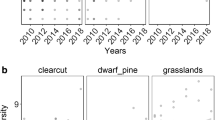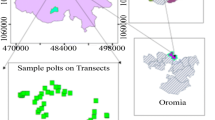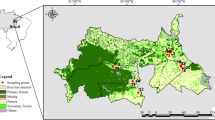Abstract
This study aimed to describe and compare the interannual changes in the diversity and population structure of herbaceous plants in an anthropogenic area that has been regenerating for 15 years and to identify the similarities and differences in the biological attributes of the community compared with the characteristics of a regenerating conserved area. In total, 105 plots measuring 1 m2 were established. In each plot, the herbaceous plants were identified, and their height and stem diameter were measured for two consecutive years. The herbaceous flora of the anthropogenic area was represented by 86 species in 70 genera and 27 families, and there were no significant differences in the average richness between years. The conserved area was represented by 71 species in 63 genera and 35 families, and there was a significant difference in the total richness between areas and between years, except when comparing the richness between the conserved area and the anthropogenic area during the second year. Considering both the anthropogenic and conserved areas, 123 herbaceous species were listed, and the similarity between areas was 60 %. For the anthropogenic area, the floristic similarity between years was 95 %, and in the fragment of the conserved area, the similarity was 74 %. The diversity and density were significantly different between years and between areas. Given these results, this study suggests that 15 years of natural regeneration for the caatinga is not sufficient to reestablish its native flora with respect to its herbaceous component.

Similar content being viewed by others
References
Albuquerque, U. P., & Lucena, R. F. P. (2005). Can apparency affect the use of plants by local people in tropical forests? Interciencia, 30(8), 506–511.
Alcoforado-Filho, F. G., Sampaio, E. V. S. B., & Rodal, M. J. N. (2003). Florística e fitossociologia de um remanescente de vegetação caducifólia espinhosa arbórea em Caruaru, Pernambuco. Acta Botanica Brasílica, 17(2), 287–303.
Andrade, J. R., Santos, J. M. F. F., Lima, E. N., Lopes, C. G. R., Silva, K. A., & Araújo, E. L. (2007). Estudo populacional de Panicum trichoides Swart. (Poaceae) em uma área de caatinga em Caruaru, Pernambuco. Revista Brasileira de Biociências, 5, 858–860.
Araújo, E. L. (2005). Estresses abióticos e bióticos como forças modeladoras da dinâmica de populações vegetais da caatinga. In R. J. M. C. Nogueira et al. (Eds.), Estresses ambientais: Danos e benefícios em plantas (pp. 50–64). Recife: MXM Gráfica e Editora.
Araújo, E. L., & Ferraz, E. M. N. (2003). Processos ecológicos mantenedores da diversidade vegetal na caatinga: estado atual do conhecimento. In V. Claudino-Sales (Ed.), Ecossistemas brasileiros: Manejo e conservação (pp. 115–128). Fortaleza: Expressão Gráfica.
Araújo, E. L., Martins, F. R., & Santos, A. M. (2005). Establishment and death of two dry tropical forest woody species in dry and rainy seasons in northeastern Brazil. In R. J. M. C. Nogueira et al. (Eds.), Estresses ambientais: Danos e benefícios em plantas (pp. 76–91). Recife: MXM Gráfica e Editora.
Araújo, E. L., Silva, K. A., Ferraz, E. M. N., Sampaio, E. V. S. B., & Silva, S. I. (2005). Diversidade de herbáceas em microhabitats rochoso, plano e ciliar em uma área de caatinga, Caruaru- PE. Acta Botânica Brasílica, 19(2), 285–294.
Araújo, E. L., Castro, C. C., & Albuquerque, U. P. (2007). Dynamics of Brazilian caatinga—a review concerning the plants, environment and people. Functional Ecology and Communities, 1, 5–28.
Behera, S. K., & Misra, M. K. (2006). Floristic and structure of the herbaceous vegetation of four recovering forest stands in the Eastern Ghats of India. Biodiversity and Conservation, 15, 2263–2285.
Belsky, A. J. (1990). Tree/grass ratios in East African savannas: a comparison of existing models. Journal of Biogeography, 17, 483–489.
Brumitt, R. K., & Powell, C. E. (1992). Authors of plant names. London: Royal Botanic Gardens.
Clark, J. S., & McLachlan, J. S. (2003). Stability of forest diversity. Nature, 423, 635–638.
Clary, J. (2008). Rainfall seasonality determines annual/perennial grass balance in vegetation of Mediterranean Iberian. Plant Ecology, 195, 13–20.
Costa, R., Araújo, F. S., & Lima-Verde, L. W. (2007). Flora and life-form spectrum in an area of deciduous thorn woodland (caatinga) in northeastern, Brazil. Journal of Arid Environments, 68, 237–247.
Cronquist, A. (1988). An integrated system of classification of flowering plants. New York: Columbia University Press.
Drumond, M. A., Kiill, L. H. P., Lima, P. C. F., Oliveira, M. C., Oliveira, R. V., Albuquerque, S. G., et al. (2004). Estratégias para o uso sustentável da biodiversidade da caatinga. In J. M. C. Silva et al. (Eds.), Biodiversidade da caatinga: Áreas e ações prioritárias para a conservação (pp. 329–340). Brasília: Ministério do meio Ambiente: Universidade Federal de Pernambuco.
Duarte SMA, Barbosa MP, Neto JMM (2009) Avaliação das classes da cobertura vegetal no municipio de Taperoá, estado da Paraíba. Engenharia Ambiental, Espírito Santo do Pinhal.
Feitoza, M. O. M., Araújo, E. L., Sampaio, E. V. S. B., & Kiill, L. H. P. (2008). Fitossociologia e danos foliares ocorrentes na comunidade herbácea de uma área de caatinga em Petrolina, PE. In U. P. Albuquerque et al. (Eds.), Biodiversidade, potencial econômico e processos eco-fisiologicos em ecossistemas nordestinos (pp. 6–30). Recife: Comunigraf/Nupea.
Ferguson, B. G. (2001). Post-agricultural tropical forest succession: patterns, processes and implications for conservation and restoration. Ph.D Thesis. Department of Biology, University of Michigan.
Ferguson, B. G., Vandermeer, J., Morales, H., & Griffith, D. M. (2003). Post-Agricultural Succession in El Petén, Guatemala. Conservation Biology, 17(3), 818–828.
Figuerôa, J. M., Pareyn, F. G. C., Araújo, E. L., Silva, C. E., Santos, V. F., Cutler, D. F., et al. (2006). Effects of cutting regimes in the dry and wet season on survival and sprouting of woody species from the semi-arid caatinga of northeast Brazil. Forest Ecology and Management, 229, 294–303.
Forbis, T. A., Larmore, J., & Addis, E. (2004). Temporal patterns in seedling establishment on pocket gopher disturbances. Oecologia, 138, 112–121.
Francis, J. K., & Parrotta, J. A. (2006). Vegetation response to grazing and planting of Leucaena leucocephala in a Urochloa maximum-dominated Grassland in Puerto Rico. Caribbean Journal of Science, 42(1), 67–74.
Girma, T. (2001). Land degradation: a challenge to Ethiopia. Journal of Environmental Management, 27(6), 815–824.
Jia, X., Shao, M., & Wei, X. (2011). Richness and composition of herbaceous species in restored shrubland and grassland ecosystems in the northern Loess Plateau of China. Biodiversity and Conservation, 20, 3435–3452.
Knapp, A. K., Fay, P. A., Blair, J. M., Collins, S. L., Smith, M. D., Carlisle, J. D., et al. (2002). Rainfall variability, carbon cycling, and plant species diversity in mesic grassland. Science, 298, 2202–2205.
Krebs, C. J. (1989). Ecological methodology. New York: Harper & Row Publishers.
Kushwaha, S. P. S., & Nandy, S. (2012). Species diversity and community structure in sal (Shorea robusta) forests of two different rainfall regimes in West Bengal, India. Biodiversity and Conservation, 21, 1215–1228.
Lima, E. N., Araújo, E. L., Sampaio, E. V. S. B., Ferraz, E. M. N., Silva, K. A., & Pimentel, R. M. M. (2007). Fenologia e dinâmica de duas populações herbáceas da caatinga. Revista de Geografia, 24, 124–145.
Lopes, C. G. R., Ferraz, E. M. N., Castro, C. C., Lima, E. M., Santos, J. M. F. F., Santos, D. M., et al. (2012). Forest succession and distance from preserved patches in the Brazilian semiarid region. Forest Ecology and Management, 271, 115–123.
Luoga, E. J., Witkowski, E. T. F., & Balkwill, K. (2004). Regeneration by coppicing (resprouting) of miombo (Africa savanna) trees in relation to land use. Forest Ecology and Management, 189, 23–35.
Maracajá, P. B., & Benevides, D. S. (2006). Estudo da Flora Herbácea da Caatinga no Município de Caraúbas no Estado do Rio Grande do Norte. Revista de Biologia e Ciências da Terra, 6, 165–175.
McCray, J. K., Walsh, B., & Hammett, A. L. (2005). Species, sources, seasonality and sustainability of fuelwood commercialization in Malaya. Forest Ecology and Management, 205, 299–309.
McLaren, K. P., & McDonald, M. A. (2003). The effects of moisture and shade on seed germination and seedling survival in a tropical dry forest in Jamaica. Forest Ecology and Management, 183, 61–75.
Mekuria, W., Veldkamp, E., Nyssen, H. J., Muys, B., & Gebrehiwot, K. (2007). Effectiveness of exclosures to restore degraded soils as a result of overgrazing in Tigray, Ethiopia. Journal of Arid Environmental, 69, 270–284.
Mori, S. A., Silva, L. A. M., & Lisboa, G. (1989). Manual de manejo do herbário fanerogâmico. Ilhéus: Centro de Pesquisa do Cacau.
Nascimento, V. T., Sousa, L. G., Alves, A. G. C., Araújo, E. L., & Albuquerque, U. P. (2008). Rural fences in agricultural landscapes and their conservation role in an area of caatinga (dryland vegetation) in Northeast Brazil. Environment, Development and Sustainability, 11(5), 1005–1029.
Negrero-Castilho, P., & Hall, R. B. (2000). Sprouting capability of 17 tropical tree species after overstory removal in Quintana Rôo, Mexico. Forest Ecology and Management, 126, 399–403.
Nippert, J. B., Knapp, A. K., & Briggs, J. M. (2006). Intra-annual rainfall variability and grassland productivity: can the past predict the future? Plant Ecology, 184, 65–74.
Noel, F., Porcher, E., Moret, J., & Machon, N. (2006). Connectivity, habitat heterogeneity, and population persistence in Ranunculus nodiflorus, an endangered species in France. The New Phytologist, 169, 71–84.
Nyssen, J., Poesen, J., Moeyersons, J., Deckers, J., & Mitiku, L. A. (2004). Human impact on the environment in the Ethiopian and Eritrean highlands—a state of the art. Earth Science Reviews, 64, 273–320.
Parthasarathy, N., & Karthikeyan, R. (1997). Plant biodiversity inventory and conservation of two tropical dry evergreen forests of the Coromondal coast, south India. Biodiversity and Conservation, 6, 1063–1083.
Paulos, D. (2001). Soil and water resources and degradation factors affecting productivity in Ethiopian highland agro-ecosystems. Northeast African Studies, 8(1), 27–51.
Pereira, I. M., Andrade, L. A., Sampaio, E. V. S. B., & Barbosa, M. R. V. (2003). Use-history effects on structure and Flora of Caatinga. Biotropica, 35(2), 154–165.
Pivello, V. R., Shida, C. N., & Meirelles, S. T. (1999). Alien grasses in Brazilian savannas: a threat to the biodiversity. Biodiversity and Conservation, 8, 1281–1294.
Price, J. N., & Morgan, J. W. (2007). Vegetation dynamics following resource manipulation in herb-rich woodland. Plant Ecology, 188, 29–37.
Rasingam, L., & Parthasarathy, N. (2009). Diversity of understory plants in undisturbed and disturbed tropical lowland forests of Little Andaman Island, India. Biodiversity and Conservation, 18, 1045–1065.
Raunkiaer, C. (1934). Life forms of plants and statistical plant geography. Oxford: Clarendon Press.
Reis, A. M., Araújo, E. L., Ferraz, E. M. N., & Moura, A. N. (2006). Inter-annual variations in the floristic and population structure of an herbaceous community of “caatinga” vegetation in Pernambuco, Brazil. Revista Brasileira de Botânica, 29(3), 497–508.
Sá e Silva, I. M. M., Marangon, L. C., Hanazaki, N., & Albuquerque, U. P. (2008). Use and knowledge of fuelwood in three rural caatinga (dryland) communities in NE Brazil. Environment. Development and Sustainability, 11(4), 833–851.
Sá, I. B., Riché, G. R., & Fotius, G. A. (2004). As paisagens e o processo de degradação do semi-árido nordestino. In J. M. C. Silva et al. (Eds.), Biodiversidade da caatinga: Áreas e ações prioritárias para a conservação (pp. 17–36). Brasília: Ministério do meio Ambiente: Universidade Federal de Pernambuco.
Salo, L. F. (2004). Population dynamics of red brome (Bromus madritensis subsp. rubens): times for concern, opportunities for management. Journal of Arid Environments, 57, 291–296.
Sampaio, E. V. S. B., Araújo, E. L., Salcedo, I. H., & Tiessen, H. (1998). Regeneração da vegetação após corte e queima, em Serra Talhada, PE. Revista Brasileira de Pesquisa Agropecuária, 33, 621–632.
Santos, J. M. F. F., Andrade, J. R., Lima, E. N., Silva, K. A., & Araújo, E. L. (2007). Dinâmica populacional de uma espécie herbácea em uma área de floresta tropical seca no Nordeste do Brasil. Revista Brasileira de Biociências, 5, 855–857.
Shepherd, G. J. (1995). FITOPAC 1. Editora UNICAMP, Campinas: Manual do usuário.
Silva, K. A., Lima, E. N., Santos, J. M. F. F., Andrade, J. R., Santos, D. M., Sampaio, E. V. S. B., et al. (2008). Dinâmica de gramíneas em uma área de caatinga de Pernambuco-Brasil. In U. P. Albuquerque et al. (Eds.), Biodiversidade, potencial econômico e processos eco-fisiologicos em ecossistemas nordestinos (pp. 105–129). Recife: Comunigraf/Nupea.
Silva, K. A., Araújo, E. L., & Ferraz, E. M. N. (2009). Estudo florístico do componente herbáceo e relação com solos em áreas de caatinga do embasamento cristalino e bacia sedimentar, Petrolândia-PE. Acta Botânica Brasília, 23(1), 100–110.
Teckle, K. (1999). Land degradation problems and their implications for food shortage in South Wello, Ethiopia. Environmental Management, 23, 419–427.
Volis, S., Mendlinger, S., & Ward, D. (2004). Demography and role of the seed bank in Mediterranean and desert populations of wild barley. Basic and Applied Ecology, 5, 53–64.
Yayneshet, T., Eik, L. O., & Moe, S. R. (2009). The effects of exclosures in restoring degraded semi-arid vegetation in communal grazing lands in northern Ethiopia. Journal of Arid Environments, 73, 542–549.
Zar, J. H. (1996). Bioestatistical Analysis. New Jersey: Prentice Hall.
Acknowledgments
The authors would like to thank the National Council for Scientific and Technological Development (Conselho Nacional de Desenvolvimento Científico e Tecnológico—CNPq) for financial support (process 4718005/2007-6), the station at the Agricultural Research Company of Pernambuco (Empresa Pernambucana de Pesquisa Agropecuária—IPA) for their logistical support and permission to work in the area, and the Graduate Program in Botany at the Federal Rural University of Pernambuco for providing the master’s student fellowship. The authors would also like to thank experts Maria Bernadete Costa e Silva and Lucilene Lima dos Santos for the identification of some species and all of the trainees at the Plant Ecology of Natural Ecosystems Laboratory (Laboratório de Ecologia Vegetal de Ecossistemas Naturais—LEVEN) for their assistance in the data collection.
Author information
Authors and Affiliations
Corresponding author
Rights and permissions
About this article
Cite this article
Santos, J.M.F.F., Santos, D.M., Lopes, C.G.R. et al. Natural regeneration of the herbaceous community in a semiarid region in Northeastern Brazil. Environ Monit Assess 185, 8287–8302 (2013). https://doi.org/10.1007/s10661-013-3173-8
Received:
Accepted:
Published:
Issue Date:
DOI: https://doi.org/10.1007/s10661-013-3173-8




